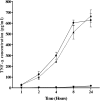Killing of Treponema denticola by mouse peritoneal macrophages
- PMID: 20200417
- PMCID: PMC2868591
- DOI: 10.1177/0022034510363105
Killing of Treponema denticola by mouse peritoneal macrophages
Abstract
Treponema denticola has been identified as an important cause of periodontal disease and hypothesized to be involved in extra-oral infections. The objective of this study was to investigate the role of T. denticola cell length and motility during mouse peritoneal macrophages in vitro uptake. Macrophages, incubated under aerobic and anaerobic conditions, produced a similar amount of TNF-alpha when stimulated with Escherichia coli LPS. The uptake of FlgE- and CfpA-deficient mutants of T. denticola was significantly increased compared with the wild-type strain, due to cell size or lack of motility. Opsonization with specific antibodies considerably improved the treponemes' uptake. These results suggest that macrophages, in addition to other phagocytes, could play an important role in the control of T. denticola infection, and that the raising of specific antibodies could improve the efficacy of the immune response toward T. denticola, either at an oral site or during dissemination.
Figures




References
-
- Cavrini F, Sambri V, Moter A, Servidio D, Marangoni A, Montebugnoli L, et al. (2005). Molecular detection of Treponema denticola and Porphyromonas gingivalis in carotid and aortic atheromatous plaques by FISH: report of two cases. J Med Microbiol 54(Pt 1):93-96 - PubMed
-
- Ehmke B, Beikler T, Riep B, Flemmig T, Gobel U, Moter A. (2004). Intraoral dissemination of treponemes after periodontal therapy. Clin Oral Investig 8:219-225 - PubMed
-
- Ellen RP, Galimanas VB. (2005). Spirochetes at the forefront of periodontal infections. Periodontol 2000 38:13-32 - PubMed
-
- Foschi F, Cavrini F, Sambri V, Montebugnoli L, Prati C. (2005). Detection of bacteria in endodontic samples by polymerase chain reaction assays and association with defined clinical signs in Italian patients. Oral Microbiol Immunol 20:289-295 - PubMed
Publication types
MeSH terms
Substances
Grants and funding
LinkOut - more resources
Full Text Sources
Molecular Biology Databases

